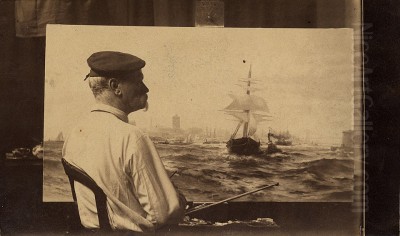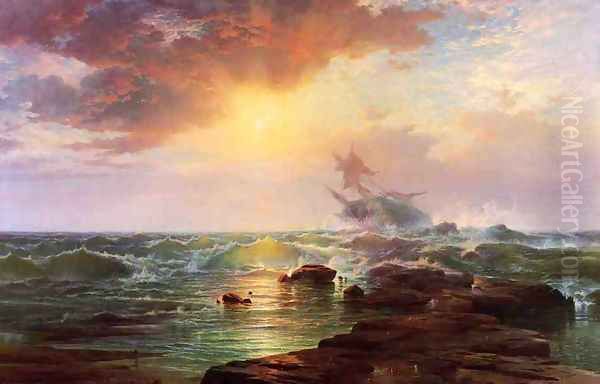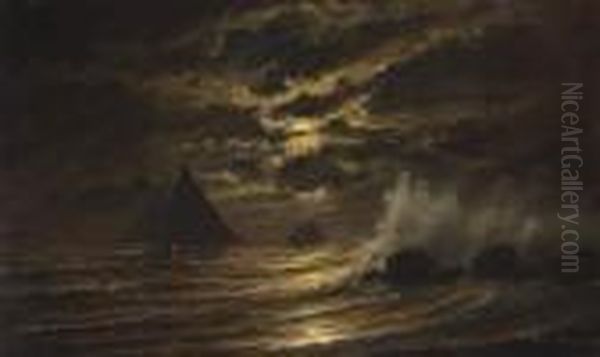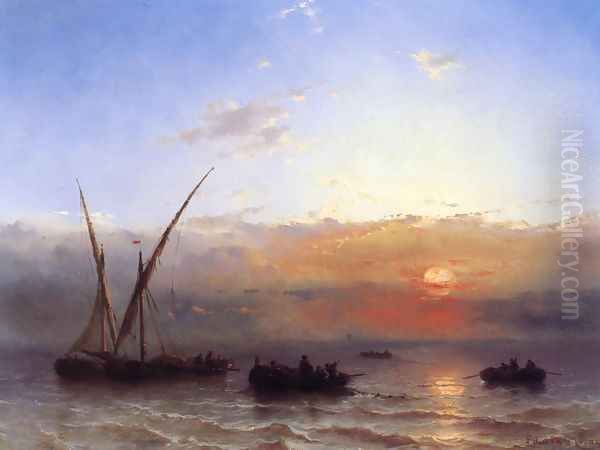
Edward Moran stands as a significant figure in nineteenth-century American art, celebrated primarily for his evocative and often dramatic marine paintings. Born in England but forging his career in the United States, Moran captured the power, beauty, and historical significance of the sea, becoming one of the preeminent maritime artists of his era. His work ranged from tranquil moonlit harbors to tempestuous ocean storms and ambitious historical narratives, securing his place not only as a skilled painter but also as a visual chronicler of America's relationship with the ocean. He was also the patriarch of a notable artistic family, further cementing the Moran name in American art history.
From Lancashire Looms to Philadelphia Studios
Edward Moran's journey began not by the sea, but in the industrial heartland of England. He was born on August 19, 1829, in Bolton, Lancashire, a town known for its textile mills. His parents were Thomas and Mary Higson Moran, and his father worked as a handloom weaver. Young Edward was initially trained in the family trade, learning to operate the loom. However, his artistic inclinations surfaced early; reports suggest he preferred sketching with charcoal on scraps of white cloth over mastering the weaver's craft, hinting at the creative path he would eventually follow.
The prospect of a different life beckoned across the Atlantic. In 1844, when Edward was fifteen, the Moran family emigrated to the United States. They initially settled in Maryland before moving to Philadelphia the following year. Philadelphia, a burgeoning cultural and industrial center, would prove pivotal for Edward's artistic development. Though he likely continued weaving for a time to support the family, the city's artistic environment soon drew him in permanently.
Forging an Artistic Path: Early Training and Influences
Philadelphia offered Edward Moran the opportunity to transition formally from textiles to art. He sought out instruction, becoming a pupil of two influential figures in the local art scene. One was James Hamilton (1819-1878), an Irish-born painter often called "the American Turner" for his dramatic, atmospheric seascapes. Hamilton's mentorship was undoubtedly crucial in steering Moran towards marine subjects and perhaps instilling a love for dynamic light and weather effects.

Moran also studied with Paul Weber (1823-1916), a German-born artist known for his meticulously detailed landscapes, often painted in the precise manner associated with the Düsseldorf school. Weber's instruction likely provided Moran with a solid grounding in landscape composition and technique, complementing Hamilton's more romantic marine focus. During this formative period in the 1850s, Edward shared a studio with his younger brother, Thomas Moran (1837-1926), who would later achieve immense fame for his paintings of the American West. Edward served as an early mentor to Thomas, marking the beginning of a remarkable family dynasty in American art.
Broadening Horizons: London and the Legacy of Turner
Seeking to refine his skills and broaden his artistic horizons, Edward Moran traveled to England in 1862. He enrolled as a student at the prestigious Royal Academy of Arts in London. This experience exposed him directly to the masterpieces of British art, both historical and contemporary. The most significant influence from this period was undoubtedly the work of Joseph Mallord William Turner (1775-1851). Moran deeply admired Turner's revolutionary handling of light, color, and atmosphere, particularly in his seascapes.
Turner's dramatic depictions of storms, shipwrecks, and the sublime power of nature resonated with Moran's own developing interests. While Moran never fully adopted Turner's most abstract late style, the British master's influence is evident in the heightened drama, atmospheric depth, and expressive brushwork found in many of Moran's mature works. His time in London also likely reinforced his appreciation for the traditions of British marine painting and potentially exposed him to the works of other European masters, further enriching his artistic vocabulary upon his return to America. He also absorbed influences from 17th-century Dutch marine masters like Willem van de Velde the Younger, known for their detailed ship portraits and atmospheric sea views.
Establishing a Career: New York and Beyond
After his studies abroad, Moran returned to Philadelphia, his reputation growing. However, seeking a larger stage and greater opportunities, he relocated to New York City in 1872, establishing a studio there. New York was rapidly becoming the undisputed center of the American art world, offering greater access to patrons, galleries, and fellow artists. Moran quickly became a recognized figure in the city's artistic circles.
His connection to Europe remained strong, and he spent several years living and working in Paris. While direct influence from French Impressionism isn't a dominant feature of his primary marine style, his time there certainly exposed him to contemporary European artistic currents. It may have subtly informed his handling of light and color, particularly in his less formal works or landscape studies. His primary focus, however, remained the sea, interpreted through a lens shaped by his earlier training and his admiration for artists like Turner and Hamilton.
The Signature Style: Capturing the Ocean's Moods

Edward Moran's artistic identity is inextricably linked to the sea. He developed a remarkable ability to capture the ocean in its myriad forms and moods. His canvases depict tranquil harbors bathed in moonlight, bustling ports alive with maritime commerce, dramatic shipwrecks battling furious storms, and serene coastal vistas under expansive skies. His skill lay not just in accurately rendering ships and waves, but in conveying the atmosphere and emotional resonance of the scene.
Elements of American Luminism, a mid-19th-century style characterized by calm waters, horizontal compositions, meticulous detail, and a focus on subtle light effects, can be seen in some of Moran's quieter works. Paintings like "Sailboats in Moonlight" exemplify his mastery of nocturnes, capturing the silvery glow of the moon on water and sails with poetic sensitivity. However, he was equally adept at depicting the ocean's raw power, employing more vigorous brushwork and dramatic compositions reminiscent of the Romantic tradition and his influence from Turner.
Chronicler of a Nation's Maritime Soul: The Historical Series
Perhaps Edward Moran's most ambitious and unique contribution was his series of paintings depicting key moments in American maritime history. He conceived a grand project consisting of thirteen large canvases, aiming to visually narrate the nation's history through its relationship with the sea. This series, often referred to as "The American Marine Series" or "Historical Marine Paintings," spanned centuries of exploration and naval events.
The subjects ranged from the legendary arrival of Norse explorer Leif Ericsson around 1000 AD, through the voyages of Christopher Columbus and Henry Hudson, significant naval battles of the Revolutionary War and the War of 1812 (like the burning of the frigate Philadelphia), the exploits of the ironclads during the Civil War, and culminated with the triumphant return of Admiral Dewey's fleet from the Philippines following the Spanish-American War in 1899. This monumental series showcased Moran's skill as a marine painter and his patriotic dedication to celebrating American history. It remains a remarkable achievement, blending artistic prowess with historical documentation.
Other Notable Works and Themes
Beyond the historical series, Moran produced a large body of work exploring various maritime themes. "Sailboats in Moonlight," as mentioned, is a quintessential example of his popular and atmospheric nocturnes, showcasing his delicate handling of light and reflection on calm waters. He often painted scenes of New York Harbor, capturing the energy and activity of the nation's busiest port with its diverse array of vessels, from elegant yachts to working sail and steamships.

His versatility is further demonstrated by a series titled "Land and Sea," which reportedly comprised 75 paintings exploring both coastal and inland landscapes, though he remains best known for his purely marine subjects. Works depicting shipwrecks, fishing fleets, coastal storms, and tranquil sunsets over the water were all part of his extensive output, consistently demonstrating his deep understanding of naval architecture, wave dynamics, and atmospheric conditions.
The Moran Artistic Dynasty
Edward Moran was the progenitor of a significant American artistic family. His most famous sibling was Thomas Moran, whose spectacular paintings of Yellowstone and the Grand Canyon earned him widespread acclaim and a central place in the Hudson River School's later phase. While Thomas focused on the dramatic landscapes of the American West, Edward remained dedicated to the sea. Despite Edward's early mentorship role and his own considerable success, Thomas's fame eventually eclipsed his older brother's in the annals of American art history.
The artistic lineage continued with another brother, Peter Moran (1841-1914), who became known for his etchings and paintings, often featuring animal subjects and pastoral landscapes. Furthermore, Edward's own sons, Edward Percy Moran (1862-1935) and John Leon Moran (known as Leon Moran, 1864-1941), also became successful painters. Percy specialized in historical genre scenes, particularly from American colonial and Revolutionary periods, while Leon was known for his delicate depictions of society figures and genre subjects. This concentration of artistic talent within one family is a remarkable aspect of American art history.
Professional Life: Recognition and Affiliations
Edward Moran achieved considerable recognition during his lifetime. He actively participated in the art world, exhibiting his work frequently and joining prominent organizations. He began showing at the Pennsylvania Academy of the Fine Arts (PAFA) early in his career. After moving to New York, he became involved with the National Academy of Design, a prestigious institution modeled after London's Royal Academy. He was elected an Associate National Academician (ANA) in 1874 and achieved full Academician (NA) status likely around 1877 (sources vary slightly on the exact year).

Moran was also a member of the American Watercolor Society, indicating his proficiency in that medium alongside oils. His work was featured in major exhibitions, including the Philadelphia Centennial Exhibition of 1876, the Brooklyn Art Association, the Boston Art Club, and later, the Chicago Interstate Industrial Expositions between 1890 and 1893. He was also a member of the Lotos Club, a prominent New York social club for men involved in the arts and literature, though his membership reportedly ended contentiously. His paintings were acquired by important collectors and eventually entered the collections of major museums, ensuring their visibility for future generations. He exhibited alongside many great names of the era, including landscape painters like Albert Bierstadt and Frederic Edwin Church, and fellow marine specialists like Mauritz de Haas and Francis A. Silva.
Temperament and Anecdotes
Accounts suggest Edward Moran possessed a strong personality and was not afraid to assert himself. A notable incident occurred at the Pennsylvania Academy of the Fine Arts exhibition in 1868. Feeling that one of his paintings was poorly hung ("skied," or placed too high on the wall), Moran reacted dramatically. In protest, he reportedly cut the canvas from its frame and partially obscured the painting with opaque paint. This act of defiance angered the Academy's board, who threatened to remove him from their list of Academicians unless he apologized. This event highlights a passionate, perhaps volatile, temperament.
His later expulsion from the Lotos Club, attributed to his expressions of dissatisfaction with the club, further suggests a man of strong opinions who sometimes clashed with institutional structures. After his death, another conflict arose concerning his estate. The executors initially refused to release certain paintings to his widow, Annette Parmentier Moran (his second wife, also an artist), claiming they were under legal protection. The matter went to the New York Supreme Court, which ultimately ruled in favor of Mrs. Moran, granting her ownership of the contested artworks.
Later Years and Lasting Legacy
Edward Moran continued to paint actively into his later years, remaining dedicated to his maritime subjects. He passed away in New York City on June 9, 1901, at the age of 71. While his fame may have been somewhat overshadowed posthumously by that of his brother Thomas, Edward Moran's contributions remain significant. He was arguably the leading American painter specializing purely in marine subjects during the latter half of the nineteenth century.
His legacy rests on his technical skill in rendering the sea and sky, his ability to capture diverse atmospheric effects from serene calm to violent storm, and his ambitious historical series that visually documented America's maritime heritage. His work provides a valuable link between the earlier marine traditions, the influence of European Romanticism (especially Turner), and aspects of American Luminism. Though perhaps not as revolutionary as Winslow Homer, another contemporary master who powerfully depicted the sea, Moran holds a secure place as a master of the American seascape and the head of an important artistic family. His paintings continue to be admired in museums and private collections, offering compelling visions of the ocean's enduring power and beauty.
Conclusion: Charting America's Waters
Edward Moran dedicated his artistic life to the sea. From his early training in Philadelphia to his mature works created in New York and influenced by European masters like Turner, he consistently explored the ocean's multifaceted character. He was a master of atmosphere, capable of rendering both the tranquility of a moonlit harbor and the terrifying sublime of a storm-tossed vessel. His monumental series on American maritime history stands as a unique testament to his ambition and patriotism, securing his role as a visual historian. As a key member of the Moran artistic dynasty and a leading marine painter of his generation, Edward Moran charted a significant course through the waters of nineteenth-century American art, leaving behind a rich legacy of evocative and historically resonant seascapes.